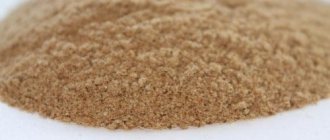Pies, pizza, cakes, dumplings, and other favorite dishes cannot be prepared without flour. It is the basis of any test. Often purchased for future use. Only over time it deteriorates, cakes, baked goods rise poorly, and a very strange taste and unpleasant smell appear. Even worse, pests attack.
Today we will find out the expiration date of flour. At the same time, we’ll tell you about the dependence on the degree of purification and select suitable storage periods. Bonus - away, bugs! We share proven ways to protect flour from food pests.
Types, varieties and expiration dates according to GOST
The shelf life of wheat flour and storage conditions are regulated by the regulatory document GOST R 52189-2003 “Wheat flour. General technical conditions". It says that the shelf life is set by the manufacturer, based on the type and variety. High-quality products retain their properties for 6 to 8 months. The higher the quality, the longer it is stored.
If we talk about other types of flour, then the specific contents are regulated by GOST 26791-89 “Grain processing products. Packaging, labeling, transportation and storage." It follows from this that:
- the properties of rye flour remain unchanged for 4-6 months;
- corn and soybean non-deodorized – 3-6 months.
- deodorized soybean – up to a year.
There are a great variety of flour milling products. It is produced both from cereals and from seeds (pumpkin), fruits (chestnut) and dried berries (bird cherry)
How to tell if flour has gone bad
A simple method is to smell it. A musty, bitter, unpleasant odor indicates spoilage. A specific aroma may appear long before the expiration date. The reason is a violation of storage rules. Sometimes spoiled products end up at home.
Signs of damage:
- presence of mold. We examine it carefully. Plaque appears on the walls of the dishes, along the edges. Further, inclusions of a different shade become noticeable in the total mass;
- hard lumps. Tracking is allowed. Such lumps easily crumble when pressed;
- rancid taste. You don't have to eat several spoons. We taste it with the tip of our tongue and spit it out.
It is impossible to extend the shelf life of a product that is starting to deteriorate. When the degree of damage is small, we actively use it. If unpleasant signs actively appear, it is better to get rid of it.
What to look for when purchasing
Package
If you buy packaged flour, then the first thing you need to pay attention to is the marking or label. Often the label is attached to bags rather than paper bags.
Labeling must contain information:
- about the variety;
- manufacturer;
- date of manufacture;
- terms and conditions of storage.
Flour is packaged in paper bags or sacks. In any case, the packaging must not be damaged. The quality of the product depends on its integrity. If stored improperly, bags and sacks may become wet or damp. It's easy to check. Run your hand over the entire surface of the packaging container. It should be dry, without streaks or diaper rash.
Organoleptic indicators
If we talk about the taste and other qualities of flour, then pay attention to:
- Smell. Flour should not smell musty, damp or rotten. A sour smell is a sign of spoilage.
- Taste. Before purchasing, you should taste the product. Firstly, it should not crunch on your teeth. Secondly, if the product is of high quality, then it has a pleasant and sweet taste.
- Consistency or structure. To check flour products, remember them in your hands. If you hear a quiet crunch during this movement, this indicates its high quality and dryness. If, after squeezing, the lump holds its shape, this is a sign that the product is damp.
- Color. It must match the type and type of product you purchased. You can check this indicator with a few drops of water. If you add liquid to a handful of flour, the quality product will not change color. If a reddish or bluish tint appears, it means that the raw material contains bran or unripe grains.
What color should this or that variety be?
Where to keep flour
For long-term storage in an apartment, places with low humidity and constant temperature are suitable. It can be:
- Kitchen cabinets.
Housewives usually use wall-mounted ones, but those that stand on the floor are much more suitable. Below, the temperature is usually 1-2 degrees lower and more stable.
- Pantry.
- Refrigerator shelf.
- A balcony or loggia is suitable for storing large supplies in winter, provided that they are glazed and insulated.
It is recommended to allocate a separate shelf for flour or place it away from vegetables.
How to store at home
Storing flour at home must meet all the requirements specified by the manufacturer on the product packaging. It is important to consider several points at once:
- humidity and air temperature;
- cleanliness of the premises;
- selection of containers;
- precise control of expiration dates.
It is important for a good housewife to choose the right place and container in which the flour will be constantly kept. If the product sits at home for a long time, its quality must be checked periodically.
Conditions
To prevent the flour from spoiling, monitor the temperature and humidity. The temperature should not be higher than 25 °C. The closer it is to 5 °C, the less likely it is to spoil.
If it is possible to place flour in rooms where the temperature is closer to zero, then the shelf life of the product increases. Such an environment may be in the basement or pantry, but it is important to take into account the humidity of the air. It should not be higher than 70%. The higher this indicator, the faster the flour will disappear.
Note to the hostess
It is absolutely wrong to keep flour in the refrigerator, as there is moisture there that can spoil the product.
Place
The shelf life of flour directly depends on the room where it is located. At home, the best places for her would be:
- pantry;
- lumber room;
- basement;
- balcony;
- separate closet with lockable doors;
- lower shelves, closer to the floor, in the kitchen.
All these rooms must be well ventilated. Air needs to circulate. Additionally, it is recommended to check the humidity parameters.
If you are going to store flour in the kitchen, choose a place for it closer to the floor. High temperatures, vapors rise to the ceiling, so the top shelves are not suitable.
Any grain products should not be exposed to light. It is better to keep the product in a dark place or in a light-proof container
Tara
How to store flour? Most often it is sold in paper bags. If you do not have a suitable container to pour the product into, you can also leave it in the original paper packaging. The main thing is to carefully close the bag using a paper holder or clothespin. Air and moisture should not get into it.
It is better to pour the flour into a special container for long-term storage. Suitable for this purpose:
- canvas bag;
- tightly closing plastic container;
- glass jar with lid.
The main thing is that no moisture gets into the product. If the container does not close hermetically, it is important to check the flour from time to time, since pests may grow in it.
Tip of the day
Periodically wipe the shelves where the flour is kept with a weak solution of vinegar or laundry soap.
Shelf life of flour
The suitability of this product directly depends on the primary raw materials, its processing technology, packaging, and storage conditions.
Wheat
This type of flour can be used from 6 to 18 months. Such a wide range is explained by the quality of the primary raw materials, the presence of additional components in the composition, and purpose. If the product contains impurities of different types, the shelf life will be shorter. Wheat flour is used for biscuits, cakes, pastries, and bakery products. All products made from this flour turn out fluffy and airy.
Rye
It is better to store rye flour in a warm and dark place. Then, within one year, you can use it to bake sourdough bread, gingerbread, and pancakes.
Corn
Can be stored for no more than 120 days. Products made from corn flour have a rich taste and bright aroma. It is easy to prepare with your own hands. By grinding grains or cereals with a coffee grinder, you can prepare a lot of juicy and tasty cakes.
Buckwheat
Ground buckwheat does not contain gluten and contains many unique microelements and vitamins. For about a year it can be used for cocktails (together with milk, kefir), and added to other varieties for baking.
Oatmeal
Products made from this flour are widely used in the confectionery and baking industries. People for whom gluten is contraindicated consume products made from this type of flour.
For about six months, flour can be used for baking diet cakes and oat pancakes.
Rice
This type is used in baby food, as a component of Asian cuisine (noodles) and as a thickener for sauces. The uniqueness of the flour lies in its hypoallergenic and absorbent properties, which do not disappear for 9 months.
Linen
How long does this type of flour last? Flour can be stored for 8 to 12 months. Products made from it are rarely found in stores. Due to the fact that it contains fiber, antioxidants, and phytoestrogens, its purpose is cosmetology and diet therapy.
Almond
For this variety, peeled almonds are used. Flour is added to pastries, muffins, cookies, cakes, thereby enriching the products with a unique nutty taste. The flour can be used within one year.
Containing protein and antioxidants, flour is added to wheat flour in a ratio of 1 to 6. It can be stored for up to 10 months.
Cheremukhovaya
This exotic type of flour is not produced on an industrial scale. It is combined with other types of flour, enriching the products with phytoncides and making them low-calorie.
Shelf life – 1 year.
Pumpkin
This species improves human health, gets rid of parasites, and promotes endurance of the body. Pumpkin seeds are used as the primary raw material for flour.
As a complete dish and as an additive, flour can be used for a long time - 365 days.
Chickpeas
The flour can be used within one year. This type is ideal as a breading (it does not absorb oil during frying). Vegetarians and raw foodists resort to this type of flour, as it contains a lot of protein.
Coconut
Used for flatbreads, muffins, biscuits, and for making sauces and gravies. This eco-friendly variety, made from coconut, is good for up to one and a half years.
Meat and bone
This is living fuel, fertilizer, livestock feed. If the flour is kept in a dark room with low humidity, it can be used for up to one and a half years.
How to store flour without getting bugs
When stored at home, insects appear if the product is not used for a long time or if it is kept in conditions favorable to bugs.
To prevent pests, use old fashioned methods. Place 2-3 cloves of unpeeled garlic in a container for 2-3 kg of flour. It releases aromatic substances that repel bugs. Also suitable for these purposes:
- dry cloves;
- calendula flowers;
- Bay leaf.
Place the plants in a piece of gauze and tie them tightly so that they do not spill out.
Why do bugs appear in flour?
Often thrifty housewives one day discover various living creatures in flour. This product is to the taste of many bugs: flour beetles, weevils, bread borers, Suriname flour beetles, and food moths.
Insects, migrating, look for better living conditions. Many bugs, attracted by the light, fly into the window and choose cereals or flour as their place of residence. Adults can get home with food from a store where it was stored in unsanitary conditions.
How to avoid it
To get rid of living creatures in flour, you need to resort to a whole range of measures:
- First of all, everything should be thoroughly cleaned and washed. Cleaning is done in all kitchen cabinets, shelves, and drawers.
- After all the scattered cereal has been collected and the surface has been cleaned, you can begin processing.
- 9 percent vinegar is diluted with water (proportion 1:1). All horizontal and vertical surfaces are treated with this composition. Vinegar will destroy adults, larvae, and eggs.
- Baking soda can be a substitute for vinegar. Two tablespoons of salt are dissolved in warm water (1 liter), everything is mixed well.
- Storage containers also need to be treated. Glass and plastic containers are thoroughly washed and scalded with boiling water.
- Fabric bags are washed and boiled.
- You can resort to pyrethrum by spraying it in your cabinets.
Optimal temperature and humidity indicators and properly selected containers will help preserve the beneficial properties of flour for a long time, prolonging its shelf life, providing the table with delicious and fluffy baked goods.
Rate this post
General recommendations
The shelf life of flour largely depends on its original state. If you buy flour of the highest quality, it will be much easier to store it, and the risks of unwanted microorganisms in it are reduced.
However, regardless of the grade and type of flour, it is important to take into account general recommendations for storing the product:
- Temperature. Maintain the temperature range from +5 to +20 degrees Celsius. Too high or low a temperature negatively affects the quality of the product itself - its binding properties decrease, and the risk of insects in it increases. In addition, the temperature must be stable - avoid sudden changes.
- Humidity. The drier the air where the flour is stored, the better. It should not exceed 60-65%, otherwise the flour will become a good place for the development of pathogenic microflora and will quickly begin to deteriorate.
- Condensate. Pay attention to the choice of container - condensation should not form on its inner walls, which will lead to the formation of mold.
- Light. Choose dark places for placement, since artificial and natural light also leads to premature deterioration of the product.
- Pests. Pay special attention to additional protection of flour from insects and pests, since they can appear quickly and also spread to other products lying nearby.
Be sure to read the flour storage recommendations indicated on the manufacturer's packaging. They may vary between varieties and types of product, so do not neglect this advice.
The video also explains how to store flour:
Storage errors
Premature spoilage of flour, the formation of pathogenic microflora in it in the form of insects or pests, or the appearance of mold on the walls of the container in which it is stored - all these factors indicate an incorrect approach to its storage.
The most common errors encountered in product storage are:
- Storing flour in store-bought paper packaging after opening. It does not protect the contents from external influences, which is why it often begins to deteriorate after a couple of weeks.
- Pouring fresh flour into the same container as the old one. So, at the bottom of the container there may be flour that was poured into it several years ago, which is why such mixing quickly leads to its attenuation and spoilage.
- Storage in non-airtight packaging. Before placing the product for a long period of time, it is important to check that the lid of the container is tightly closed and does not allow moisture, oxygen and foreign odors to pass through.
- Place the product on an unheated balcony. Temperature differences and their constant fluctuations negatively affect its shelf life. If the thermometer reading completely drops to negative values, the flour loses its properties and becomes unsuitable for use and further consumption.
How to identify a quality product
To store flour, it is necessary that it is initially of high quality. In an unsealed container, you can see it and determine the presence of unexpected contamination, but it is more difficult with closed bags and bags, where the product cannot be assessed visually. How to determine the quality of flour by external signs and in products made from it:
- the presence of a sour-bitter taste,
- stale product has a musty smell,
- If the flour is very cold to the touch, it means it has been in conditions of high humidity and requires immediate drying.
How to maintain the high quality of the product in the apartment so that it does not lose its beneficial properties and taste.
Insect protection
There are old, time-tested methods of protecting against insects that love to live in flour.
- If you plan to use cotton bags for storage, then before pouring the flour into the bag, soak it in a concentrated salt solution (3 tablespoons per 1 liter of water) and dry it well (no need to rinse in clean water). The salt will repel moths and bugs, and the flour will be safe.
- The most affordable way to protect against pests is to put a few unpeeled cloves of garlic in the flour. Use 2 slices per 1 kg. flour. Volatile substances (phytoncides), which garlic contains in large quantities, effectively repel insects.
- There is another method of combating flour bugs - dried calendula flowers. Calendula is poured into a large bag, into which a smaller bag of flour is placed. This way the flowers will not get into the flour and will repel insects.
- Bay leaves will help repel pests. Interestingly, having a pronounced odor, it will not harm the flour.
- A modern way to protect flour supplies from visits from uninvited guests is to use mint chewing gum. If you put several open packs of mint gum next to the bag, insects will not get into it.
- The shelf on which the bag of flour is stored should be treated with acetic acid once every 7 days.
- If it happens that pests have already settled in the flour, do not despair. It can be sifted through a fine-mesh sieve and poured again into another container. To ensure that all insects are killed, the flour can be placed in the oven. Heat treatment should be carried out for 10 -15 minutes at a temperature of +100°C.
- You cannot use a container in which pests have infested - they may come back again. Therefore, before reuse, the container is thoroughly washed and rinsed with a salt solution. After complete drying, the container can be reused.
Selection of storage containers
The shelf life of flour largely depends on the quality of the choice of containers into which you transfer it. You should not leave it in a store-bought paper bag, since it is most often thin and can quickly be exposed to external influences.
However, if the packaging has not yet been opened, you can leave the product in this state for a while, additionally putting it in a plastic bag for greater tightness.
After opening, pour the product into an existing container or container. The following options are suitable for this:
Glass container (for example, a jar)
Wooden container
Metal container
Plastic container or bucket
Canvas bag
When choosing a container for storage, pay attention to its tightness. If we are talking about containers made of various materials, they must have tight-fitting lids that will protect their contents from outside influences.
Also keep in mind that pouring new flour into the same container as the old one is not recommended, just like mixing varieties, so empty and clean the container before pouring the new product.
Housewives often store flour in plastic bottles, which is strictly not recommended. The fact is that they are made of thin plastic, which absorbs surrounding odors well and is exposed to external influences.
What kind of flour lasts for how long?
Flour is made from different types of grains. In short, anything that can be ground into a powder can become flour.
| View | Storage duration, month |
| Wheat | 6-8 |
| Rye | 4-6 |
| Buckwheat | 12 |
| Corn | 3-6 |
| Barley | 6 |
| Rice | 6 |
| Linen | 8 |
| Almond | 6 |
| Soy non-deodorized/deodorized | 3-6/12 |
Note
The maximum shelf life is for premium wheat flour, the minimum for whole grain flour.
Additional Information:
- Pea - 8-10 months
- Pumpkin - 9-12 months
- Chickpeas – 24 months
- Coconut – 24 months
- Barley – 6 months
- Blinnaya – 6 months
When purchasing, be sure to look at the manufacturing date. If the expiration date is approaching, it is better to buy flour elsewhere. Or choose a package with an expiration date that will allow you to keep it at home for a long time.
Initially, the flour should be dry. If the conditions were incorrect before it came to you, you need to dry it by spreading it in a thin layer. Store in a dry, dark place without access to odorous substances and products. Humidity 60%, temperature from 0 to 5 degrees.
If you follow all of the above, the shelf life of flour can be increased to 10 years. But periodically you need to check whether it has deteriorated, whether it has changed color and taste, or whether there are bugs in it. Such inspections are carried out at least 2 times a year.
Only wheat flour of the highest grade and excellent quality can be stored for up to 10 years.
If flour is contained in bags, be sure to place the bottom ones on pallets. Twice a year, everything needs to be shifted so that the lower ones move to the top.










